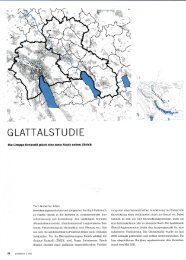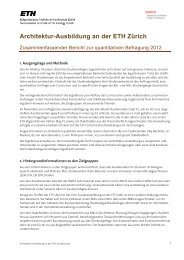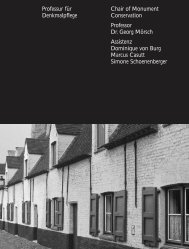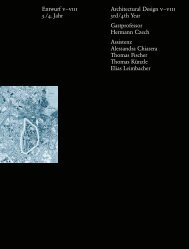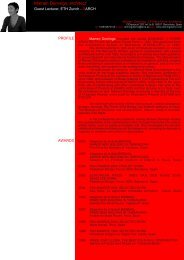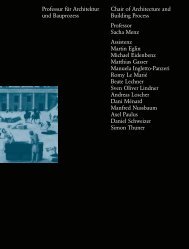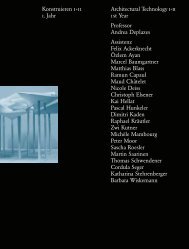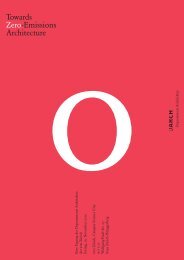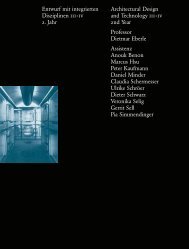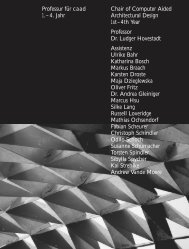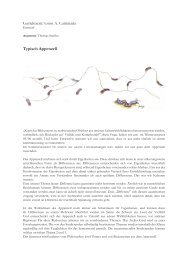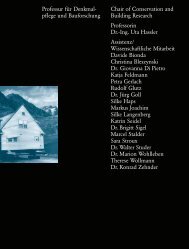Jahrbuch PDF (63MB) - ETH Zurich - ETH Zürich
Jahrbuch PDF (63MB) - ETH Zurich - ETH Zürich
Jahrbuch PDF (63MB) - ETH Zurich - ETH Zürich
Erfolgreiche ePaper selbst erstellen
Machen Sie aus Ihren PDF Publikationen ein blätterbares Flipbook mit unserer einzigartigen Google optimierten e-Paper Software.
Website<br />
http://www.gta.arch.<br />
ethz.ch/d/stalder<br />
links:<br />
Jean Balladur, La Grande<br />
Motte, 1976 (Fotograf:<br />
Lehre Teaching<br />
Jede theoretische Arbeit zielt auf wissenschaftliche Erkenntnis<br />
ab. Dementsprechend ist auch der Anspruch der<br />
Theorie der Architektur ein wissenschaftlicher, dient<br />
sie doch dem Untersuchen, Erklären und Begründen von<br />
Architektur und deren Gesetzmässigkeiten. Ihr Diskurs<br />
ist dabei ein doppelter: einerseits, ein der Architektur immanenter,<br />
der von der Skizze über das Modell bis zur<br />
Bauausführung reicht, andererseits ein über Architektur<br />
reflektierender, wenn Architektur als Ausdruck einer<br />
kulturell bedingten Praxis interpretiert wird. Vor diesem<br />
zweifachen Hintergrund zeichnen sich aber die historische<br />
Bedingtheit, die Interessenbestimmtheit und damit<br />
die Relativität jeglicher theoretischen Auseinandersetzung<br />
ab.<br />
In diesen widersprüchlichen Bedingungen liegt die<br />
Herausforderung des Unterrichts in Architekturtheorie,<br />
kann doch weder ein rein spekulativer Ansatz, der den<br />
unterschiedlichen kulturellen, sozialen, ökonomischen<br />
oder technischen Entwicklungen ein normierendes<br />
System überstülpt, noch ein allzu eng aus der Praxis abgeleitetes,<br />
jeder Systematik widerstrebendes Modell der<br />
Aufgabe der Disziplin gerecht werden. Ziel der Lehre<br />
soll deshalb die Analyse und Kritik einzelner, historisch<br />
und kulturell eingebetteter Denkmodelle sein, um<br />
daraus die Instrumente zum eigenständigen Denken von<br />
Architektur erarbeiten zu können.<br />
Die Lehre verfolgt zwei Schwerpunkte. Gegenstand der<br />
Vorlesung und der Seminarwoche ist die Architektur der<br />
Nachkriegszeit in Westeuropa und Nordamerika. Dabei<br />
werden der architektonische Diskurs und seine Strategien<br />
im Umgang mit sich immer wieder verändernden<br />
gta<br />
technischen Erfindungen und sozialen Praktiken<br />
Robert D. Loevy) Institut<br />
untersucht. Im Vordergrund stehen dementsprechend<br />
weniger einzelne Architekten oder Bauten als vielmehr<br />
unterschiedliche Themen wie «Habitat», «Cluster»,<br />
«Mobilität» oder «Spektakel», die für die Architektur der<br />
Zeit bestimmend waren.<br />
Das Wahlfachseminar hingegen untersucht die Bedingungen<br />
zeitgenössischer architektonischer Produktion.<br />
Dabei wird systematisch der Bedeutung einzelner<br />
architektonischer Elemente – wie Schwelle, Boden, Rahmen<br />
oder Stütze, aber auch Geräte, Mobilien und Leitungen –<br />
nachgegangen. Die architektonischen Elemente werden<br />
aus zwei Perspektiven untersucht. Ein erster, historischer<br />
Ansatz soll den einzigartigen Charakter einzelner<br />
baulicher Lösungen aufzeigen und dadurch auf die Möglichkeiten<br />
und zugleich auf die Notwendigkeit einer<br />
zeitgenössischen Antwort verweisen. Der zweite, interdisziplinäre<br />
Ansatz widmet sich der Frage nach aktuellen<br />
Diskursen über Architektur als soziale, ökonomische, technische<br />
oder ästhetische Praxis.<br />
Erste Ergebnisse aus der Forschung zum Seminar<br />
werden im März 2009 in einer Ausgabe der Zeitschrift<br />
«Arch+» zum Thema «Architektur der Schwelle»<br />
publiziert.<br />
171<br />
Every theoretical work aims for scholarly insights. Correspondingly,<br />
the goal of architectural theory is also<br />
scholarly, as it serves to study, explain, and justify architecture<br />
and its rules. Its discourse thus has two aspects:<br />
on the one hand, one immanent to architecture that ranges<br />
from the sketch by way of the model to the construction<br />
of the building; on the other hand, one that reflects on<br />
architecture and interprets it as the expression of a culturally<br />
determined practice. It is against this dual backdrop,<br />
however, that conditioning by history, determination by<br />
interests, and hence a relativity with respect to any<br />
theoretical debate become obvious.<br />
These contradictory circumstances constitute the<br />
challenge of teaching architectural theory, since neither a<br />
purely speculative approach that imposes a standardizing<br />
system on various cultural, social, economic, and technical<br />
developments nor a model derived all too closely<br />
from practice and rejecting any systematic structure will<br />
do justice to the task of the discipline. The goal of<br />
teaching should thus be to analyze and criticize specific<br />
models of thinking that are embedded in history<br />
and culture in order to develop the instruments for<br />
autonomous thinking about architecture.<br />
The teaching of the professorship has two focuses.<br />
The subject of the lecture course and the seminar week<br />
excursion is postwar architecture in Western Europe<br />
and North America. Both will examine the architectural<br />
discourse and its strategies for dealing with constantly<br />
changing technical inventions and social practices. The<br />
focus will thus be less on individual architects or<br />
single buildings than on various themes that defined the<br />
architecture of the time, defined by concepts such as<br />
‘habitat’, ‘cluster’, ‘mobility’, or ‘spectacle’.<br />
The elective seminar, by contrast, will study the conditions<br />
of contemporary architectural production. It<br />
will systematically investigate the meaning of specific<br />
architectural elements — such as threshold, floor,<br />
framework, or support, but also devices, furnishings, and<br />
conduit. The architectural elements will be examined<br />
from two perspectives. The first, an historical approach is<br />
intended to show the unique character of specific<br />
architectural solutions and thus point to the possibilities<br />
but also the necessity of a contemporary response.<br />
The second, interdisciplinary approach is dedicated to<br />
the question of current discourses on architecture as<br />
a social, economic, technological, or aesthetic practice.<br />
Initial results of the research for the seminar will<br />
be published in March 2009 in an issue of the journal<br />
‘Arch+’ that will focus on the ‘architecture of the<br />
threshold’.<br />
Departement Architektur<br />
Laurent Stalder



